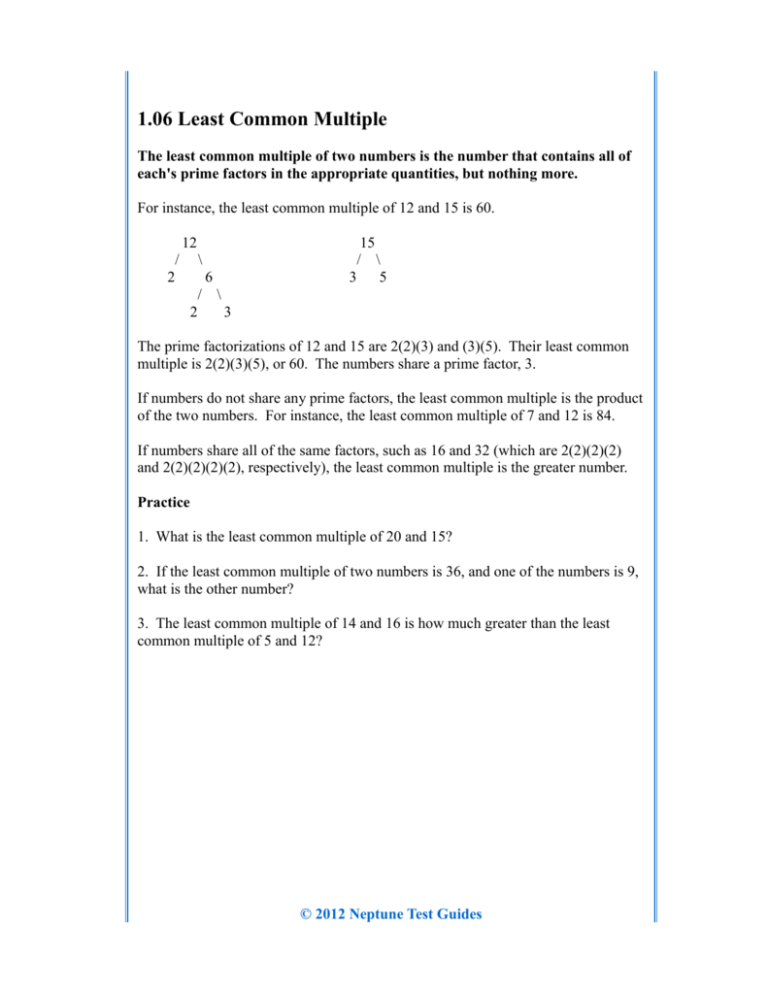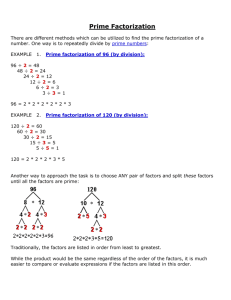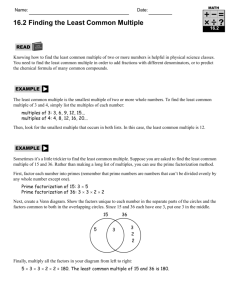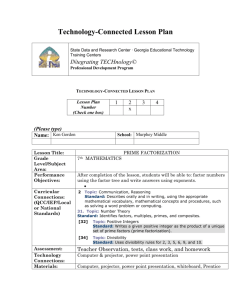1.06 Least Common Multiple
advertisement

1.06 Least Common Multiple The least common multiple of two numbers is the number that contains all of each's prime factors in the appropriate quantities, but nothing more. For instance, the least common multiple of 12 and 15 is 60. 12 / 15 / \ 3 5 \ 2 6 / 2 \ 3 The prime factorizations of 12 and 15 are 2(2)(3) and (3)(5). Their least common multiple is 2(2)(3)(5), or 60. The numbers share a prime factor, 3. If numbers do not share any prime factors, the least common multiple is the product of the two numbers. For instance, the least common multiple of 7 and 12 is 84. If numbers share all of the same factors, such as 16 and 32 (which are 2(2)(2)(2) and 2(2)(2)(2)(2), respectively), the least common multiple is the greater number. Practice 1. What is the least common multiple of 20 and 15? 2. If the least common multiple of two numbers is 36, and one of the numbers is 9, what is the other number? 3. The least common multiple of 14 and 16 is how much greater than the least common multiple of 5 and 12? © 2012 Neptune Test Guides 1.06 Least Common Multiple Answers to Practice Questions 1. 60 20 / 2 15 / \ 3 5 \ 10 / \ 2 5 The prime factorization of 20 is 2(2)(5), while the prime factorization of 15 is (3) (5). Their least common multiple will thus be 2(2)(3)(5) - the number which contains all of the prime factors of each in the appropriate quantities, but nothing more. The numbers share a common factor - 5 - thus, the 5 need not be repeated. 2. 4 36 / \ 4 9 / \ / \ 2 2 3 3 9 / \ 3 3 The prime factorization of 36 is 2(2)(3)(3). The prime factorization of 9 is 3(3). Since 36 is the least common multiple of 9 and the other number, this other number must be 2(2), or 4, since the least common multiple of two numbers is the number which contains the prime factors of each in the appropriate quantities, but nothing more. © 2012 Neptune Test Guides 1.06 Least Common Multiple Answers to Practice Questions 3. 52 This requires solving for the least common multiple of both pairs of numbers. 14 / 2 \ 7 16 / \ 2 8 / \ 2 4 / \ 2 2 The prime factorization of 14 is 2(7), while the prime factorization of 16 is 2(2)(2) (2). The least common multiple of the numbers is thus 2(2)(2)(2)(7) or 122 - they share a factor, 2, which thus need not be repeated. As for the other two numbers, 5 is prime, and 12 breaks into 2(2)(3). They have no factors in common, and their least common multiple is their product, 60. This is 52 less than 112. © 2012 Neptune Test Guides







